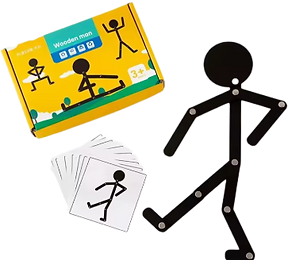Computational Thinking Lessons with Manipulatives
This page provides simple introductory computational thinking (CT) lessons for elementary students. These unplugged lessons use typical classroom manipulatives for a tactile, concrete exploratory experience.

Partners turn their backs to each other. One partner uses the pattern block to create something. Then without looking partner 2 attempts to recreate the design by strictly following the directions of partner 1. Swith roles. Generally, this results in an inaccurate representation which demonstrates the important a precise langague.
Pattern Blocks
Grades: 3-5
Main Skill: Algorithm

In this lesson, students will practice computational thinking by playing a game. The game uses physical rings to form a Venn diagram. Then, foam objects with different colors, 2D shapes, and sizes are placed in the rings. One student brainstorms two secret rules for the Venn diagram, and the other tries to guess the rules.
This is an approach that uses concept attainment. Concept attainment is an instructional strategy where students, through examining examples and non-examples, identify the defining characteristics of a concept, fostering inductive reasoning and deep learning.
Venn Diagram
Grades: 3-5
Main Skill: Abstraction

In this activity, students create a model using snap blocks one block high and create a code so someone else can build their model. The lesson comes from the Digital Technology Hub (Australia). This lesson was kindly provided by Jackie Tither, a teacher in Tasmania who implemented the lesson with her year 2 class.
Snap Cubes
Grades: PreK-2
Main Skill: Pattern Recognition

Children will make playdough creations and engage in problem decomposition as they make creations. Children will identify all the SMALLER tasks they can tackle to make their BIG creation. Children will share their thoughts about breaking down the parts to make the BIG task easier. As children engage in this activity they will have opportunities to identify and replicate shapes, count objects, compare lengths, and explore cardinality.
Play Doh
Grades: PreK-2
Main Skill: Decomposition

In this lesson, students practice the computational skill of abstraction. They make a collection of animals that have something in common (e.g., they are insects), and their partner attempts to name the commonality. When students generalize from examples to an idea, they are abstracting.
Classify This
Grades: 1-2
Main Skill: Abstraction

Dancing with Algorithms is a 50-minute lesson for 2nd-grade students to develop computational thinking skills through choreography. Students learn about algorithms, sequencing, and debugging by creating and following step-by-step dance routines using a wooden stick figure. Working in pairs, one student acts as the "programmer" to design a sequence, while the other follows the instructions as the "computer." The lesson concludes with reflection and an exit ticket, reinforcing connections between algorithmic thinking and daily routines.
Wooden Man
